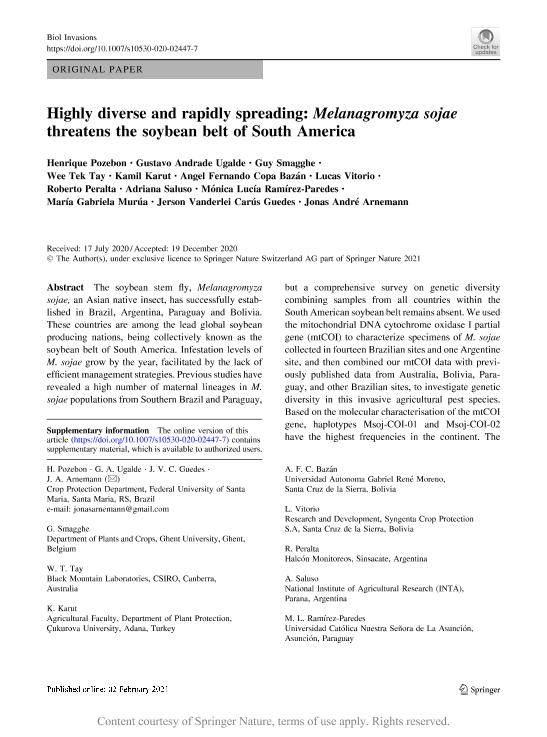Mostrar el registro sencillo del ítem
dc.contributor.author
Henrique Pozebon
dc.contributor.author
Ugalde, Gustavo Andrade
dc.contributor.author
Smagghe, Guy

dc.contributor.author
Tay, Wee Tek
dc.contributor.author
Karut, Kamil
dc.contributor.author
Copa Bazán, Angel Fernando
dc.contributor.author
Vitorio, Lucas
dc.contributor.author
Peralta, Roberto
dc.contributor.author
Saluso, Adriana

dc.contributor.author
Ramírez Paredes, Mónica Lucía
dc.contributor.author
Murúa, María Gabriela

dc.contributor.author
Vanderlei Carús Guedes, Jerson
dc.contributor.author
Arnemann, Jonas André
dc.date.available
2023-01-10T11:31:26Z
dc.date.issued
2021-05
dc.identifier.citation
Henrique Pozebon; Ugalde, Gustavo Andrade; Smagghe, Guy; Tay, Wee Tek; Karut, Kamil; et al.; Highly diverse and rapidly spreading: Melanagromyza sojae threatens the soybean belt of South America; Springer; Biological Invasions; 23; 5; 5-2021; 1405-1423
dc.identifier.issn
1387-3547
dc.identifier.uri
http://hdl.handle.net/11336/184058
dc.description.abstract
The soybean stem fly, Melanagromyza sojae, an Asian native insect, has successfully established in Brazil, Argentina, Paraguay and Bolivia. These countries are among the lead global soybean producing nations, being collectively known as the soybean belt of South America. Infestation levels of M. sojae grow by the year, facilitated by the lack of efficient management strategies. Previous studies have revealed a high number of maternal lineages in M. sojae populations from Southern Brazil and Paraguay, but a comprehensive survey on genetic diversity combining samples from all countries within the South American soybean belt remains absent. We used the mitochondrial DNA cytochrome oxidase I partial gene (mtCOI) to characterize specimens of M. sojae collected in fourteen Brazilian sites and one Argentine site, and then combined our mtCOI data with previously published data from Australia, Bolivia, Paraguay, and other Brazilian sites, to investigate genetic diversity in this invasive agricultural pest species. Based on the molecular characterisation of the mtCOI gene, haplotypes Msoj-COI-01 and Msoj-COI-02 have the highest frequencies in the continent. The high genetic diversity found is evidence of introductions involving multiple female founders into the continent, and the high proportion of unique mtDNA haplotypes identified from Brazil, Paraguay and Bolivia (~ 50%) suggests potential novel introductions have taken place. The findings from our study will contribute to a better understanding of M. sojae genetic diversity in South America, supporting the development of management strategies for this highly invasive pest and assisting with biosecurity preparedness of other emerging Agromyzidae flies of economic importance.
dc.format
application/pdf
dc.language.iso
eng
dc.publisher
Springer

dc.rights
info:eu-repo/semantics/openAccess
dc.rights.uri
https://creativecommons.org/licenses/by-nc-sa/2.5/ar/
dc.subject
AGROMYZIDAE
dc.subject
GENETIC DIVERSITY
dc.subject
GLYCINE MAX
dc.subject
MOLECULAR CHARACTERIZATION
dc.subject
SOYBEAN STEM FLY
dc.subject.classification
Zoología, Ornitología, Entomología, Etología

dc.subject.classification
Ciencias Biológicas

dc.subject.classification
CIENCIAS NATURALES Y EXACTAS

dc.title
Highly diverse and rapidly spreading: Melanagromyza sojae threatens the soybean belt of South America
dc.type
info:eu-repo/semantics/article
dc.type
info:ar-repo/semantics/artículo
dc.type
info:eu-repo/semantics/publishedVersion
dc.date.updated
2022-09-21T15:33:57Z
dc.journal.volume
23
dc.journal.number
5
dc.journal.pagination
1405-1423
dc.journal.pais
Alemania

dc.journal.ciudad
Berlin
dc.description.fil
Fil: Henrique Pozebon. Universidade Federal de Santa Maria; Brasil
dc.description.fil
Fil: Ugalde, Gustavo Andrade. Universidade Federal de Santa Maria; Brasil
dc.description.fil
Fil: Smagghe, Guy. University College Ghent; Bélgica
dc.description.fil
Fil: Tay, Wee Tek. No especifíca;
dc.description.fil
Fil: Karut, Kamil. Cukurova University; Turquía
dc.description.fil
Fil: Copa Bazán, Angel Fernando. No especifíca;
dc.description.fil
Fil: Vitorio, Lucas. No especifíca;
dc.description.fil
Fil: Peralta, Roberto. No especifíca;
dc.description.fil
Fil: Saluso, Adriana. Instituto Nacional de Tecnología Agropecuaria; Argentina
dc.description.fil
Fil: Ramírez Paredes, Mónica Lucía. Universidad Catolica Nuestra Señora de la Asuncion,; Paraguay
dc.description.fil
Fil: Murúa, María Gabriela. Consejo Nacional de Investigaciones Científicas y Técnicas. Centro Científico Tecnológico Conicet - Tucumán. Instituto de Tecnología Agroindustrial del Noroeste Argentino. Provincia de Tucumán. Ministerio de Desarrollo Productivo. Estación Experimental Agroindustrial "Obispo Colombres" (p). Instituto de Tecnología Agroindustrial del Noroeste Argentino; Argentina
dc.description.fil
Fil: Vanderlei Carús Guedes, Jerson. Universidade Federal de Santa Maria; Brasil
dc.description.fil
Fil: Arnemann, Jonas André. Universidade Federal de Santa Maria; Brasil
dc.journal.title
Biological Invasions

dc.relation.alternativeid
info:eu-repo/semantics/altIdentifier/doi/https://doi.org/10.1007/s10530-020-02447-7
Archivos asociados
